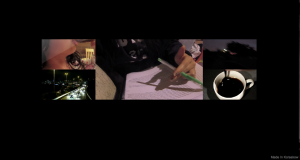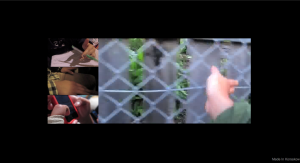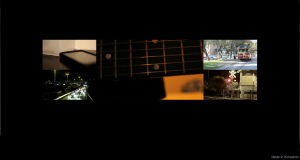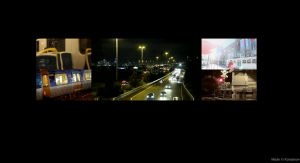Category: Assessment
Integrated Media Participation
What did you do well?
I comprehensively logged my progress throughout the semester and adhered to my weekly participation contract goals. I worked well in collaborating with my group, asked questions when unsure, utilised my technical and creative skills for the weekly sketch tasks, read each weekly reading, attended all lectures and took notes. I utilised the class and blog instructions introducing the new software. I used Korsakow well, adapted suggestions and participated in class discussion. I also watched a range of interactive documentaries to broaden my understanding of the medium.
What have you learnt to do better?
I have developed a deeper understanding of the purpose of the subject in helping to prepare me for the ever-evolving and challenging industry. I now know how to adapt to different forms of software to tell stories and therefore distance myself from the familiar and traditional film making structure and techniques. I understand the purpose of interactive documentary in the way the relations are more important than the content and the way the parts form a whole. I have also learnt how to utilise my blog including categories and linking to useful sources that will be useful later in the semester. I have slightly improved my formal critiquing and writing skills.
What could you have learnt to do better?
I would have benefited from relating the weekly readings to my own work and adapting those techniques into my work from an earlier stage. I also could have improved my interview techniques from an earlier stage as I required those for the group Korsakow film and this would have assisted in creating better quality content. I could have consistently utilised my blog in creating more detailed critiques of other works, as some weekly posts were too brief.
Completed Participation Contract
Here is my completed participation contract.
Imogen’s Sketch Film
K-Film Essay
K-Film Essay
Life is a Musical created by Denise Gregorio, Mike Chmielewski and Daniel Daly in 2012 is available through this link. http://vogmae.net.au/classworks/2012/LifeisaMusical.html
Introduction
The Korsakow film Life is a Musical is an observational work that uses pattern, interface and content to draw attention to noises created by ordinary objects and human activities. The clips comprise of routine behaviours and the organisation of these prompt the viewer to unite various repetitive sounds within the film. These clips and sounds signify the unobserved song that plays in life. This abstract work focuses on the unusual sound qualities of subjects and objects that an individual would overlook in reality.
Pattern
Life is a Musical presented a variety of connections between the clips that allowed the viewer to establish concepts within the work as a whole. The recurring themes of travel, machines and human behaviour frequent the clips within a variety of environments through abstract form. Relations were made between the repetitions of obvious sounds within visually simplistic shots. These were presented in the context of suburban and urban surroundings at various times of day. The rhythms are evident in the looped clips that allude to the idea that noises within environments form part of a broader symphony in the world. The patterns that present travel, machine and human behaviour evolved through the structure of the clips. There was a grouping of clips that displayed noises created by transportation, technology and people, all of which engaged with one-another. The clips that involved these themes were associated so the viewer could form a significant meaning.
Interface
This interactive documentary assigned varied interface designs to each clip so they were presented as a unique component of the film. The SNU window dimensions were altered in a clip of a guitar string. The preview windows changed position, as did the number of windows displayed. Some designs presented the preview windows side-by-side where as others had spaces in-between. On some occasions, the preview windows did not align with the SNU window. The lack of consistency in the interfaces transformed the appearance of each clip. These unique experiences helped the viewer maintain interest in the varying content. The clips were played on a loop until a preview window was selected. They did not appear to die after numerous views because these ordinary sounds are repeated numerously each day.
Content
Life is a Musical employed an assorted quality of footage within the observational clips and the filmmakers occasionally employed editing. The visuals were technically simple, but diverse in style. Some of the audio contained distorted wind sounds within footage recorded in open spaces.
The film began with a title page before the first SNU window appeared. The first grouping involved clips displaying transport in suburban areas at night. These included footage of cars driving below an overpass on a freeway (https://www.mediafactory.org.au/imogen-tyers/?p=129). The next range of clips consisted of various machines filmed in an abstract style including close up shots of a vibrating mobile phone (https://www.mediafactory.org.au/imogen-tyers/?p=132). These related to clips that incorporated machines with individuals such as shots of an individual creating sound with an instrument (https://www.mediafactory.org.au/imogen-tyers/?p=135). These clips were followed by single shots of people creating noises through movement including a hand running along a wire fence in a tracking shot (https://www.mediafactory.org.au/imogen-tyers/?p=138). The clips finally linked human behaviour to transport via an abstract clip of an individual running in darkness. This last clip relied heavily on the sound of footsteps and panting to comprehend the action.
The soundtrack of the film was comprised of noises within the clips including a high pitched clinking sound from an individual stirring a mug of coffee and an edited clip of a glass door being continuously slammed shut with a thud. Jump cuts were utilised to disconnect dialogue and transform it into a rhythm. The editing was used to repeat noisy components within footage to increase the focus on rhythms in the common environments.
Connection
The choices made in the content captured, the patterns created and the interface designed formed into themes that were interpreted to provide the audience with a general understanding of the interactive documentary. Machines provide humans with communication and transportation. People interact with these various forms of machinery and unintentionally create sounds. When the diverse clips were viewed continuously, they constructed a song. This film encourages the viewer to notice the soundtrack being created in their lives through machines, travel and other human behaviour. This reflective film presented extracts of the everyday, which caused the viewer to feel as though they were travelling through fragmented time and space. They experienced varied activities that suggested noises were a source of music, rather than just sounds. The patterns formed through the content suggested themes of travel, machine and human behaviour, which dominate daily life. The diverse content within the clips were reflected in the varied design of the interface. The content, pattern and interface showcased the familiar noises as the music of life.
Evidence
The interactive documentary Life is a Musical is an example of an abstract work that connects unrelated objects through the repetition of similar elements to form themes that develop new meaning for the viewer (Bordwell & Thompson 2013). The abstract organisation contrasts visuals with other images to emphasise significant physical attributes such rhythmic noises within the shots. This observational style influences the viewer to see the world differently through noticing the accentuated abstract sound qualities in everyday objects. This interactive documentary is an example of the predicted increase in availability of new technological resources that has allowed this new method of expression (Sørenssen 2008). The change in the way audiences engage with media is evident as the viewer chooses the story through a selection of observational clips. This non-linear medium opens up possibilities for story telling through the versatile and non-fictional form of documentary as it allows viewers to draw their own interpretations. Life is a Musical can be recognised as a hypertext as it allows the viewer to create their own journey through selecting a series of existing options (Ashton and Gaudenzi 2012).
—————————————————————————
References
Aston, J & Gaudenzi, S 2012, ‘Interactive Documentary: Setting the Field’, Studies in Documentary Film, vol. 6, issue 2, pp. 125 – 139.
Bordwell, D & Thompson K, 2013, Film Art: An Introduction, McGraw-Hill, New York, 2013, p.p. 356-370.
Gregorio, D, Chmielewski, M & Daly, D 2012, Life is a Musical, interactive documentary, viewed 30 March 2014, <http://vogmae.net.au/classworks/2012/LifeisaMusical.html>.
Sørenssen, B 2008, ‘Digital Video and Alexandre Astruc’s Caméra-Stylo: The New Avant-Garde in Documentary Realized?’, Studies in Documentary Film, vol. 2, issue 1, pp. 47 – 59.




